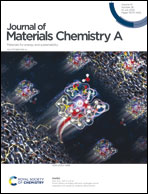Density functional theory study of a two-atom active site transition-metal/iridium electrocatalyst for ammonia synthesis†
Abstract
Ammonia (NH3) is one of the most important basic chemicals and is used worldwide in both industry and agriculture. The main industrial process for the production of NH3 is the Haber–Bosch process, which requires a large amount of energy as a result of the use of high temperatures and pressures, making it costly, inefficient, and environmentally unfriendly. Because of the growing demand for NH3 in industry and agriculture, the development of alternative technologies, especially those having low energy consumption and producing little pollution, is urgently required. The electrocatalytic nitrogen reduction reaction (NRR) is an example of such a reaction. However, the efficiency of the NRR is limited by the high N![[triple bond, length as m-dash]](https://www.rsc.org/images/entities/char_e002.gif) N bond strength and the competitive hydrogen evolution reaction (HER). Therefore, current implementations of the NRR are not suitable for industrialization. To enable the use of the NRR in an industrial setting, high-performance electrocatalysts are required. In this study, density functional theory calculations were used to investigate the performance of NRR electrocatalysts based on the transition metal doped Ir(100) surface to yield two-atom active sites (TM2@Ir(100)) from an energetic perspective. Mn2@Ir(100) and Fe2@Ir(100) were determined to have high catalytic activities for the NRR based on the screening of the adsorption energies and activation of N2, formation of adsorbed N2H, desorption of adsorbed NH3, and HER inhibition. Finally, using these two catalysts, the energetics of the whole NRR pathway were calculated. The key findings are that the para-doped Mn2@Ir(100) catalyst affords excellent NH3 selectivity and NRR activity with an extremely low free energy barrier of 0.36 eV.
N bond strength and the competitive hydrogen evolution reaction (HER). Therefore, current implementations of the NRR are not suitable for industrialization. To enable the use of the NRR in an industrial setting, high-performance electrocatalysts are required. In this study, density functional theory calculations were used to investigate the performance of NRR electrocatalysts based on the transition metal doped Ir(100) surface to yield two-atom active sites (TM2@Ir(100)) from an energetic perspective. Mn2@Ir(100) and Fe2@Ir(100) were determined to have high catalytic activities for the NRR based on the screening of the adsorption energies and activation of N2, formation of adsorbed N2H, desorption of adsorbed NH3, and HER inhibition. Finally, using these two catalysts, the energetics of the whole NRR pathway were calculated. The key findings are that the para-doped Mn2@Ir(100) catalyst affords excellent NH3 selectivity and NRR activity with an extremely low free energy barrier of 0.36 eV.



 Please wait while we load your content...
Please wait while we load your content...